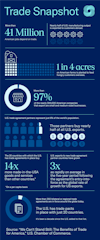Former Executive Vice President and Head of International Affairs, U.S. Chamber of Commerce
Published
December 20, 2022
The economy is slowing, and recession fears are rising. For several years, government spending has played an outsized role in driving economic growth — but with deficits soaring, this can’t go on forever.
The American economy needs growth. In our Calling on Congress series we have so far examined how to achieve that by finding ways to fill the many vacant jobs across the country and increasing the number of public companies.
Our economic growth also hinges on trade. Americans derive huge benefits from trade. More than 30% of all private sector jobs in the U.S. depend on trade — especially in key sectors like manufacturing and agriculture.

But unfortunately, America is not yet moving the needle on trade. To be fair, the Biden Administration did launch the Indo-Pacific Economic Framework for Prosperity this past year which the U.S. Chamber does support in principle – but many governments and corporate leaders are skeptical that this will lead to real economic growth because there is no market access in the agreement and no compelling reason why governments in Asia will go along and accept U.S. standards in such areas as digital trade without tangible benefits to them.
It has been a decade since the United States added to the list of 20 countries where we have free-trade agreements (FTAs) in force. Meanwhile, other economies are racing to ink new trade deals including the EU and China.
If the United States continues to stand still, we’ll lose export sales and the domestic jobs they support – not to mention weakening strategic alliances.
FTAs are crafted to make trade fair. U.S. negotiators use them to lower the steep tariffs other countries levy on U.S. exports as well as other “non-tariff” barriers. U.S. exports to other countries face an average tariff of 6.8%, roughly three times the level the U.S. imposes.
According to a report by the World Economic Forum, the U.S. ranks a disastrous 130th out of 136 economies in terms of the “tariffs faced” by our exports overseas.
One major reason American exporters are often at a disadvantage in key foreign markets is that so many other countries have negotiated FTAs with one another.
According to the World Trade Organization (WTO), 354 bilateral or plurilateral FTAs are in force around the globe today — up from about 100 at the turn of the century. However, as noted, the United States has FTAs with just 20 countries.
This means U.S. exporters are often among a minority paying tariffs to sell their wares in key markets.
Nor is the situation getting easier. In the critical Indo-Pacific region, huge multi-country trade agreements like the Regional Comprehensive Economic Partnership and the Comprehensive and Progressive Trans-Pacific Partnership are providing workers, companies, and farmers from the participating countries with preferential access to one another’s markets.
It isn’t just Asia, either. The EU has trade agreements in place with 78 countries, Canada with 54, Mexico 50, and China 35. And Africa is hard at work making its continental free-trade zone a reality.
The U.S. may be the only country whose government says — against all this evidence — that trade pacts are out of fashion.
And yet, the record of America’s FTAs is remarkably positive. While U.S. FTA partners represent just 6% of the world’s population outside the United States, in recent years they have regularly purchased nearly half of all U.S. exports.
Further, U.S. exports to new FTA partner countries have grown roughly three times as rapidly on average in the five-year period following the agreement’s entry-into-force as the global rate of growth for U.S. exports, as Chamber research shows.
U.S. FTAs have eliminated duties on approximately 99% of tariff lines in almost every case (and 100% in some instances). In this regard, U.S. FTAs are often far superior to those negotiated by other countries. They’re based on principles of fairness, openness, and accountability.
In recent months, members of Congress on both sides of the aisle have spoken out about the need for America to get off the sidelines and back in the game on trade.
This should come as no surprise: The Constitution gives Congress the leading role on trade policy, assigning it the power “to regulate commerce with foreign nations” and the authority to impose tariffs.
Congressional trade leaders have laid out trade priorities that the U.S. Chamber strongly supports, including the following:
- Resume negotiations for new FTAs with the UK, America’s closest ally, and Kenya, a promising market in East Africa, and explore launching negotiations with Ecuador, Uruguay, and others;
- Raise our ambitions in the Indo-Pacific Economic Framework discussions to include tariff-elimination and market access as well as binding and enforceable rules in key areas such as digital trade; and
- Approve the Miscellaneous Tariff Bill and renew the Generalized System of Preferences, both of which enjoy broad bipartisan support.
For too long, America has been on the sidelines of trade while our economic competitors have been leaving us in the dust. If we want to create jobs and grow new industries here on our shores, there’s no excuse for our inaction on trade. Let’s get back in the game — now.
About the author
Myron Brilliant
Myron Brilliant is the former executive vice president and head of the International Affairs Division at the U.S. Chamber of Commerce.





